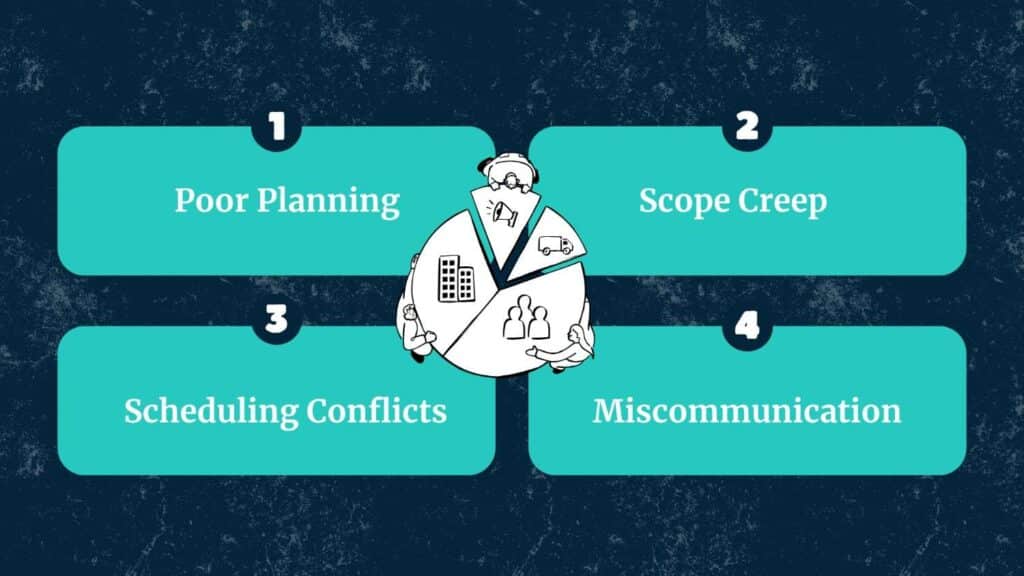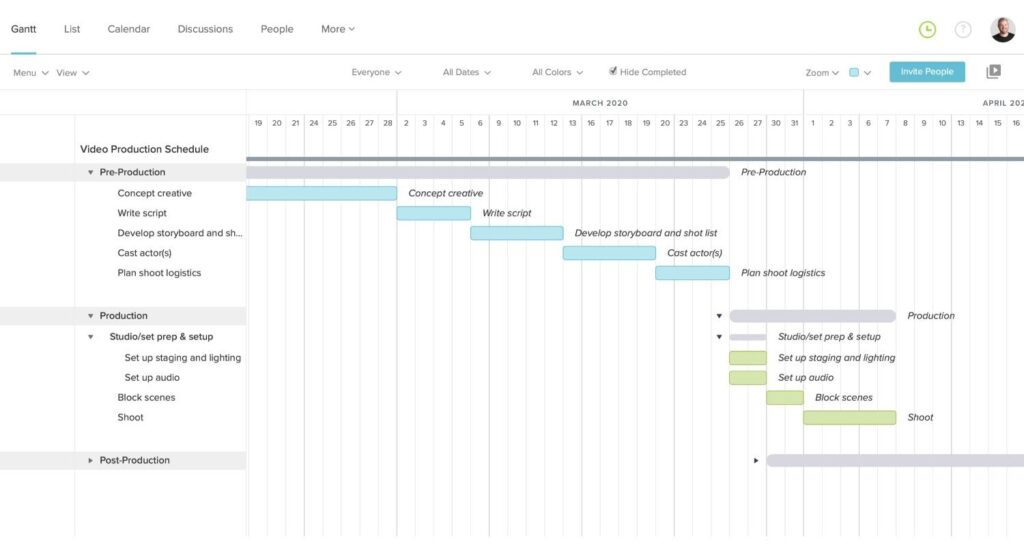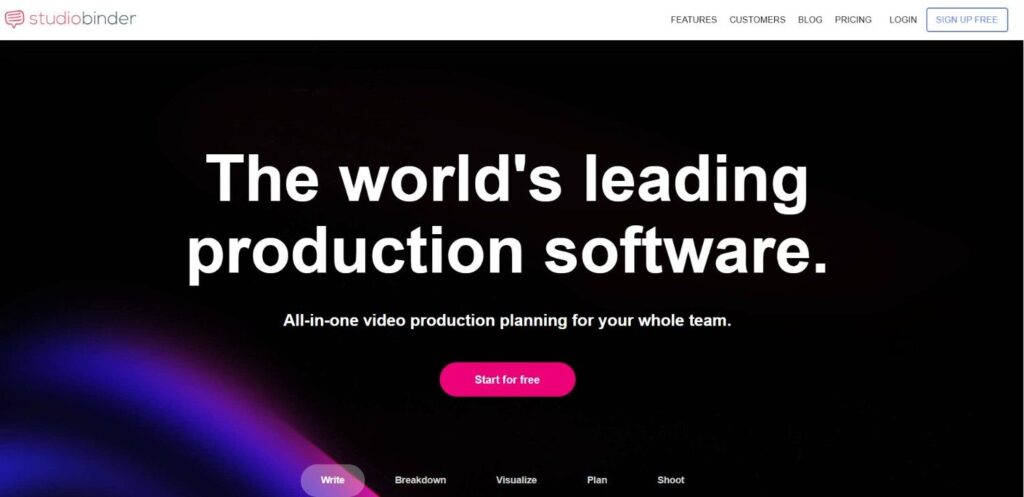In the world of video, project managers are the human version of a tripod. They keep everything stable.
Project managers don’t sweat under pressure.
They do. They can just adjust timelines in their sleep.
So, yes! Project management: turning big ideas into bankable content!
Did you ever try herding cats? Now picture those cats as last-minute script revisions, lighting technicians, directors, and editors. That’s what video production feels like without a solid plan.
Enter: project management in the film industry! The unsung hero keeps shoots on schedule and budgets from spiraling into horror movie territory.
Project management turns production mayhem into movie magic! That too under time and budget constraints.
Want your next video to run smoother than a Steadicam shot?
Why Do Video Production Projects Go Over Time and Budget?
Video production is a complex process with many moving components. It is prone to many pitfalls that could cause delays and higher expenses.
Let’s find out!

Poor Planning
Confusion during filming and post-production can result from poor planning in video production. It may show itself as a vague vision or problems with the screenplay.
It is also regarded as a crucial mistake to begin a corporate film without specific goals.
As a result, the video lacks purpose and effectiveness.
If a video’s objective and target audience are not clearly stated, even visually beautiful videos may fail. Some common pre-production errors may hinder a project.
These errors include:
- Not conducting adequate planning
- Having unclear goals
- Failing to conduct audience research
Production can also be severely delayed by inadequate or misallocated funds, labor, or equipment.
Relatable Read: Video Production Project Management: Step-by-Step Workflow for Success
Scope Creep
Scope creep is when a project’s needs progressively grow beyond what was originally agreed upon. This phenomenon is also sometimes referred to as “requirement creep” or “feature creep.”
It shows how a project’s requirements change over time.
It may also occur when the project’s objectives and vision shift to the point where they no longer align with the initial agreement. These adjustments may be little departures from the original goals.
As a result, this makes the original plan less and less effective.
Scheduling Conflicts
Scheduling problems occur when two or more obligations clash
And it is not feasible to complete them all.
For example,
- Setting up back-to-back appointments
- Holding meetings twice
During the filmmaking process, these conflicts make it more difficult to complete on time, like
- Assignments
- Appointments
- Commitments
Schedule modifications may also be necessary due to bottlenecks caused by resource limitations. Such as: restricted access to specialist facilities, props, or equipment.
Miscommunication
Miscommunication or misunderstanding is a major issue in the film industry.
As effective communication plays a great role in a project’s success.
The video production team may be disrupted if imprecise instructions are given. Also, if all stakeholders are not kept informed. Problems may arise from things like a short being misinterpreted or changed in the middle of the procedure.
So, more strong communication could prevent a lot of issues that come up during a project.
Relatable Read: Video Marketing for Startups: How to Build Brand Awareness Fast?
The Role Spectrum: Who’s Who?
Many positions in the video production process provide a well-organized workflow, transparent accountability, and efficient communication. Such as:
Producer → Line Producer → Production Manager → Project Manager
At A Glance!
| Producer | Line Producer | Production Manager | Project Manager |
| The person in charge of film production is called a producer. | A line producer is a producer of motion pictures or television shows who oversees the production’s finances and logistics. | A production manager is referred to as a Unit Production Manager (UPM). | A project manager is usually in charge of organizing, coordinating, and carrying out video projects. |
| From the beginning to the end, they manage a film’s planning, coordinating, casting, directing, editing, funding, marketing, and distribution. | They supervise all aspects of a movie’s operations and logistics. | They supervise and coordinate every facet of a motion picture production. | They are tasked with making the video a reality by bringing the planning to life. |
Relatable Read: Top 7 Cinematic Lighting Techniques Every Filmmaker Should Know
Key Project Management Strategies for On-Time Delivery
When it comes to project management in the film industry, timing isn’t just everything. It’s the entire show!
So, for a film to be produced successfully and on schedule, project management is important. It includes thorough planning, effective scheduling, and careful deadline management.
It also involves:
- Centralizing coordination
- Striking a balance between practicality and creativity
- Dealing with unforeseen obstacles
Pre-Production Planning
The first stage of filmmaking is called pre-production. During which all necessary planning, writing, budgeting, and scheduling are completed before actual filming starts. This stage is essential to avoid delays during the actual shooting process.
Script finalization: The screenplay is the guide for the whole production process. It is frequently revised multiple times in response to stakeholder input. It directs every step of the process, from scheduling and location scouting to budgeting and casting.
Casting: Casting involves determining the different roles that are needed.
It also involves:
- Receiving actor submissions
- Holding auditions
- Choosing the best candidates
For both cast and crew, contracts are written that specify roles, duties, and terms of remuneration.
Location Scouting: This involves identifying shooting sites that complement the tone of the video and the requirements of the screenplay. While also taking practical considerations like parking, permits, and lighting conditions into account.
Obtaining the required licenses and permits is crucial to preventing expensive closures and even legal repercussions.
Relatable Read: The Ultimate Pre-Production Checklist for Film & Video

[Source: Teamgantt]
Production Scheduling
Effective production scheduling is key to ensuring a film is completed on time and within budget. A well-organized schedule provides a timeline for every phase of production, from planning to the final wrap.
Call sheets: These are given to the actors and crew and contain information about the upcoming day’s shoot. Such as: call times, location details, sequences to be filmed. Call sheets must be flexible to account for unforeseen changes.
Shot lists: Making a thorough shot list and storyboards helps in effectively organizing the days of production. This guarantees that every day of shooting is fruitful by saving time and resources on set.
Daily Progress Tracking: Tracking: Preventing overspending can be achieved by routinely comparing progress to the plan. Workflows for each day are planned carefully, considering setup needs for different departments.
There are some tools that can help with real-time scheduling creation and management.
For instance:
- AI-powered platforms like Storyvord and Filmustage
- Tools like StudioBinder and Movie Magic Scheduling
Relatable Read: Video Production Planning Checklist: 10 Essential Steps for Success
Post-Production Deadlines
In the post-production stage, the unprocessed video is assembled into a coherent movie and refined using various techniques. The timely delivery of a high-quality final product depends on the effective management of this phase.
Editing: Editing is the initial stage of post-production. It involves importing and organizing unprocessed video and audio into an editing program. The basic task of video editing is cutting and compiling film to create a cohesive tale. It also involves close collaboration with the director to improve the narrative and present visual coherence.
Sound: Voiceovers, music, and sound design are crucial for balancing the film’s visual components. This comprises music, sound effects, and ambient noises, with audio mixing making sure that each component is in balance.
Client Reviews: Before the finished product is made public, quality assurance and changes are essential. This involves
- Determining whether the material is interesting
- Consistent with the brand
- Relevant to the target audience
As modifications made later in the process may result in budget overruns, it is advised to make changes as soon as possible.
From pre-production puzzles to post-production deadlines, we don’t just manage tasks, we manage peace of mind. Ready to see your video delivered like clockwork? Schedule your personalized project walkthrough with LocalEyes.
Keeping Video Production Under Budget
Keeping video production under budget isn’t just luck. It’s project management in the film industry, working its magic behind the scenes.
So, think of it as the financial stunt double!
Budget Breakdown for Video Production
A comprehensive video production budget is typically divided into three stages: pre-production, production, and post-production. With different allotments for equipment, personnel, locations, and post-production components!
Gear: The complexity of the project and the required level of quality have a major impact on the equipment cost.
- For entry-level filmmakers, a budget of approximately $2,000 is recommended to purchase a suitable camera and some basic audio equipment.
- For dedicated solo filmmakers or video producers, this amount may rise to $5,000.
Relatable Read: 10 Essential Multi-Camera Shooting Techniques for Pro Shoots
Hiring Professionals: Hiring professional actors, presenters, or voiceover artists greatly influences the quality of videos. However, the cost is determined by their reputation and level of experience.
Although experienced professionals may fetch greater fees, their value frequently makes the investment worthwhile. The biggest outlay in a movie’s budget is usually for the salaries of the cast and crew. It may vary according to roles, union affiliation, and experience.
Locations: Costs may include crew housing, permits, and transportation, depending on the location. Travel expenses and logistical difficulties are typically higher in remote or foreign places.
Location and studio rental costs can differ significantly. For example, Wadi Rum, Jordan, has a Mars-like landscape and tax perks. It allowed “The Martian” to film there for less money.
Forecasting and Contingency Planning
Forecasting involves projecting all possible costs associated with the different phases of production. Such as:
- Equipment rentals
- Set building
- Special effects
Moreover, expert film budgeting software can effectively track expenditures and offer a thorough cost summary.
To cover unforeseen costs that may come up during manufacturing, a contingency reserve is essential. Some unanticipated expenses
- Weather delays
- Equipment failures
- Post-production adjustments
As a general guideline, allocate 10–15% of the overall budget to contingencies. [Sparkhouse]
Relatable Read: Affordable Video Production: Quality Meets Budget
How Do Project Management Tools Help in Video Production?
In the world of project management in the film industry, tools are the secret sauce behind every smooth production!
Trello: Trello is a popular, straightforward, and user-friendly collaboration application that groups projects into boards.
Because of its great flexibility, users can customize lists and boards to fit their unique needs.

[Source: trello]
Trello works especially well for visual project management. It is a fantastic place to start when switching from manual lists to more reliable software.
Asana: Asana is a complete work management tool for teams that facilitates
- Project planning
- Management
- Tracking
- Communication
It lets users create lists, assign tasks, establish due dates, and track the status of projects.
Additionally, Asana provides transparency and alignment by enabling limitless real-time reporting against an organization’s project data.
Monday: Monday.com is a cloud-based work and project management tool. It is designed to help teams organize, oversee, and monitor daily tasks and projects.
Users can select and alter views and integrations because of its flexibility and customization features.
Monday.com offers templates for a range of businesses and industries. It also facilitates project centralization and granting complete visibility over efforts.
Relatable Read: 25 Best Marketing YouTube Channels to Follow in 2025!
Communication & Collaboration
Effective communication guarantees that everyone is aware of the project’s objectives, creative vision, and logistical plans right away.
It helps in bringing budget expectations into line. It also avoids situations in which the client’s expectations for production value fall short of the funds allotted.
To ensure effective communication and collaboration, follow some steps like:
- Regular check-ins, updates, and revisions
- Avoid scope creep through documented change requests
Project Management Tools for Video Production Teams
Numerous digital tools are available to video production teams to help them with budgeting, task management, and pre-production.
These tools provide many features intended to improve:
- Financial monitoring
- Efficiency
- Teamwork during a project

[Source: Studiobinder]
Pre-production: Studiobinder
StudioBinder is a web-based production tool. It was created to assist agencies in handling every facet of video production, from planning to shooting.
To avoid chaos in production, it seeks to arrange work, specify essential paths, convey progress, and respond to inquiries.
Key Features:
- AV script software
- Production calender
- Script breakdown
- Shooting schedule
- Crew and talent management
- Cloud-based and collaborative
| Pros | Cons |
| Complete production management | High price |
| User-friendly interface | Lack of customization |
| Collaboration | Limited advanced scheduling |
| Streamlined workflow | Scriptwriting focus |
| Script breakdown capabilities |
Budgeting: Wrapbook
Wrapbook is a clever, user-friendly cloud-based tool made to make accounting and production payroll for the entertainment sector more efficient.
By centralizing production administration, users
- Can pay the crew
- Keep tabs on expenses
- Coordinate teams in one location
Key features:
- Payroll management
- Production accounting and expense tracking
- Onboarding and starting work
- Dynamic reporting
- Production incentives tool
| Pros | Cons |
| Cost-effective payroll | Limited feature set |
| Integrated platform | Editing limitations |
| Real-time data | Hidden price (for certain features) |
| User-friendly | |
| Union compliance |
Lights. Camera. Managed.
So, if you think movie magic just happens, then think again. Behind every smooth shoot is strategic hustle, aka project management in the film industry!
Don’t just make a video; master the entire process with LocalEyes by your side.
Let’s turn deadlines into headlines.
Start your production journey with us today.
Frequently Asked Questions (FAQs): Project Management In Video Production
How do you make sure that projects are completed on schedule and within budget?
You can make sure that projects are completed on schedule and within budget through thorough planning, clear communication, and proactive risk management.
In video production, what is the role of a project manager?
A project manager in video production supervises the entire video creation process from beginning to end.
Does a project manager have to ensure that projects are completed on schedule and within budget?
Yes, they have to make sure that projects are completed on schedule and within budget.
In project management, how much does time cost?
In project management, time can be calculated by multiplying the number of hours spent on a project by the hourly rate of teams or individuals.

Founder at LocalEyes Video Production | Inc. 5000 CEO | Emmy Award Winning Producer



